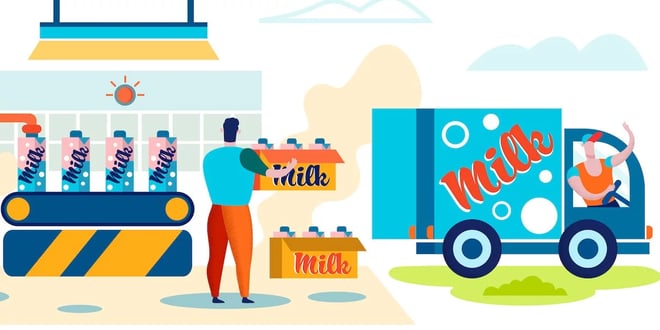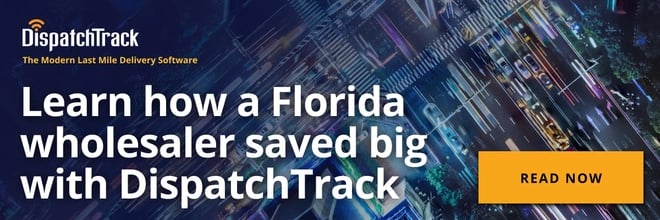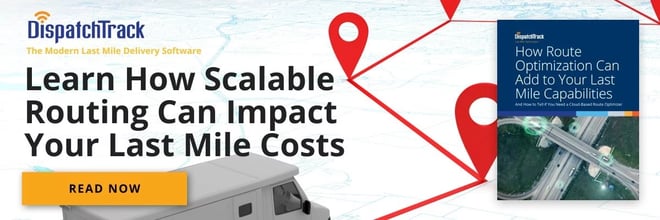Technological adoption in food distribution has ramped up its pace, as the restaurants that wholesalers work with struggle to adapt to changing circumstances and increasing volatility. When order volumes can fluctuate wildly based on news headlines and new restaurant restrictions, the old ways of routing and scheduling wholesale deliveries stop being workable options for most businesses.

This presents real challenges for food logistics businesses—but it also presents opportunities. New logistics management technology has the power to make businesses more agile and competitive in the marketplace. With the rise of things like hybrid route optimization and real-time order tracking, new potential for optimization abounds.
In this post, we will discuss some of the key challenges facing food wholesalers, as well as how logistics management software can impact the food wholesale sector’s approach to the last mile.
Major Challenges in Food Distribution's Last Mile
The primary goal of any enterprise is to increase its market share through high-value offerings to customers at the least cost possible. Many businesses in the food delivery market have upped their game by notches, which means customers have many great choices. This is most obvious in B2C context, but B2B businesses are feeling this as well. B2C customers want the so-called Amazon experience, and it takes a complex set of tools to make that experience possible.

One of the most serious hurdles to giving your B2B customers an experience more like what they experience as B2C consumers is the fact that recurring and standing orders (like you might have with restaurants or grocery stores) don’t lend themselves easily to dynamic routing. Usually, you need to make many of the same stops at the same locations day in and day out—and then add more stops between your anchor customers to better optimize your capacity and power rapid delivery turnarounds. Unfortunately, most logistics management solutions don’t offer an easy way to make that happen out of the box.
Of course, food quality standards add an extra wrinkle on top of these more basic last mile problems. One of the biggest challenges for delivery teams is the proper handling of food. Wholesalers need to make sure that their delivery teams are trained properly so they can minimize spoilage—but they also need special tools that can enable them to track temperatures of goods in transit and trace items that may be left in the truck after a delivery back to specific orders.
How Logistics Management Software Helps in Last Mile Food Distribution
Given all the above, it’s easy to imagine why automating through logistics management software is key to meeting demands while keeping operating costs low.
Last mile deliveries, regardless of what they are, tend to be the most expensive area of the supply chain—fundamentally, the last mile is complex and inefficient. But the right wholesale food distribution software ensures that last mile delivery orders are delivered on-time and fresh or of high-quality.
Here, automation can be beneficial in ensuring that every step in the last mile delivery is optimized. It also offers businesses fuel and other cost savings:

Automated Dispatching and Route Optimization
Automated dispatching replaces the manual decision-making and communication process among dispatchers and drivers. This feature increases the efficiency of scheduling and dispatching of drivers, allowing dispatchers to focus more on driver and customer relations.
Route optimization is crucial for ensuring that orders are delivered on time. Dynamic routing solutions provide the dispatchers and drivers with the most optimal routes, sparing drivers from having to pass through or navigate heavy traffic or poor road and weather conditions. At the same time, the ability to optimize static routes is crucial for many B2B delivery use cases. What dispatchers really need is a hybrid routing option that offers the best of both worlds.
Real-Time Driver Monitoring
Many dispatchers are blind to drivers’ exact location and how they are faring on the road. Automating the delivery progress allows dispatchers to spot any potential problems on the road that can cause delays.
Real-time driver monitoring also benefits customers, as they can see where their orders are or when the driver is already nearby. Knowing where the driver is at any given time is particularly crucial when it comes to food, since you don’t want to take any chances of delivery conditions impacting the quality of the food.
The right solution will provide accurate ETAs to begin with, meaning that you’ll have a manageable number of exceptions to track. When something seems to be going wrong in the field, you can spot it quickly and effect a resolution.
Digital Customer Engagement
Customer satisfaction depends on whether the company is able to meet consumer expectations. When there are unavoidable delays, how can your business communicate effectively with customers?
Companies have many options in engaging customers. They can offer real-time updates about orders, personalize communications, or use a platform that makes it easy for customers to confirm scheduled delivery windows.
The post-delivery experience should not be ignored either. Customers who are given easy ways of providing their feedback feel that they are both empowered and valued. Automation tools help companies provide both great delivery and post-delivery experiences to their customers so they keep coming back. Of course, customer feedback is most useful when you’re already providing great delivery experiences with high on-time rates.
All of the above may seem daunting—and with good reason: food distribution presents some of the most difficult constraints in last mile logistics more broadly. Fortunately, logistics management software can help you overcome the many challenges in last mile deliveries and meet new customer demands.